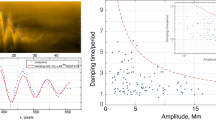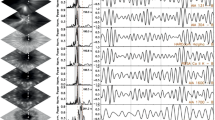Abstract
The detection of overtones of coronal loop kink oscillations has been an important advance in the development of coronal seismology. It has significantly increased the potential of coronal seismology and has thus initiated important theoretical and observational improvements. New detections of overtones have been made and a reduction of the error bars has been obtained. The efforts of theoreticians to extend eigenmode studies to more general coronal loop models is no longer a matter of checking the robustness of the model but now also allows for the estimation of certain equilibrium parameters. The frequencies of the detected (longitudinal) overtones are in particular sensitive to changes in the equilibrium properties along the loop, especially the density and the magnetic field expansion. Also, attempts have been made to use the limited longitudinal resolution in combination with the theoretical eigenmodes as an additional seismological tool.
Similar content being viewed by others
References
A. Abramowitz, I.A. Stegun, Handbook of Mathematical Functions (Dover, New York, 1965)
J. Andries, M. Goossens, Phys. Plasmas 14, 052101 (2007). doi:10.1063/1.2714513
J. Andries, I. Arregui, M. Goossens, Astrophys. J. 624, L57–L60 (2005). doi:10.1086/430347
J. Andries, I. Arregui, M. Goossens, Astron. Astrophys. 497, 265–272 (2009). doi:10.1051/0004-6361/200811481
J. Andries, M. Goossens, J. Hollweg, I. Arregui, T. Van Doorsselaere, Astron. Astrophys. 430, 1109–1118 (2005). doi:10.1051/0004-6361:20041832
I. Arregui, T. Van Doorsselaere, J. Andries, M. Goossens, D. Kimpe, Astron. Astrophys. 441, 361–370 (2005). doi:10.1051/0004-6361:20053039
I. Arregui, T. Van Doorsselaere, J. Andries, M. Goossens, Philos. Trans. R. Soc. A 364, 529–532 (2006). doi:10.1098/rsta.2005.1714
M.J. Aschwanden, J. Terradas, Astrophys. J. 686(2), L127–L130 (2008). doi:10.1086/592963
M.J. Aschwanden, L. Fletcher, C.J. Schrijver, D. Alexander, Astrophys. J. 520(2), 880–894 (1999). doi: 10.1086/307502
M.J. Aschwanden, B. de Pontieu, C.J. Schrijver, A.M. Title, Solar Phys. 206(1), 99–132 (2002). doi: 10.1023/A:1014916701283
M.J. Aschwanden, L.F. Burlaga, M.L. Kaiser, C.K. Ng, D.V. Reames, M.J. Reiner, T.I. Gombosi, N. Lugaz, W. Manchester, I.I. Roussev, T.H. Zurbuchen, C.J. Farrugia, A.B. Galvin, M.A. Lee, J.A. Linker, Z. Mikić, P. Riley, D. Alexander, A.W. Sandman, J.W. Cook, R.A. Howard, D. Odstrčil, V.J. Pizzo, J. Kóta, P.C. Liewer, J.G. Luhmann, B. Inhester, R.W. Schwenn, S.K. Solanki, V.M. Vasyliunas, T. Wiegelmann, L. Blush, P. Bochsler, I.H. Cairns, P.A. Robinson, V. Bothmer, K. Kecskemety, A. Llebaria, M. Maksimovic, M. Scholer, R.F. Wimmer-Schweingruber, Space Sci. Rew. 136(1–4), 565–604 (2008). doi:10.1007/s11214-006-9027-8
M. Aschwanden, R. Nightingale, J. Andries, M. Goossens, T. Van Doorsselaere, Astrophys. J. 598, 1375–1386 (2003). doi:10.1086/379104
P.S. Cally, Solar Phys. 103(2), 277–298 (1986). doi:10.1007/BF00147830
F.C. Cooper, V.M. Nakariakov, D. Tsiklauri, Astron. Astrophys. 397(2), 765–770 (2003). doi:10.1051/0004-6361:20021556
I. De Moortel, C.S. Brady, Astrophys. J. 664(2), 1210–1213 (2007). doi:10.1086/518830
C.E. DeForest, Astrophys. J. 661(1), 532–542 (2007). doi:10.1086/515561
A.J. Díaz, G.R. Donnelly, B. Roberts, Astron. Astrophys. 476(1), 359–368 (2007). doi:10.1051/0004-6361:20078385
A.J. Díaz, R. Oliver, J.L. Ballester, Astrophys. J. 580(1), 550–565 (2002). doi:10.1086/343039
A.J. Díaz, R. Oliver, J.L. Ballester, Astrophys. J. 645(1), 766–775 (2006). doi:10.1086/504145
A.J. Díaz, R. Oliver, J.L. Ballester, B. Roberts, Astron. Astrophys. 424(3), 1055–1064 (2004). doi:10.1051/0004-6361:20035707
G.R. Donnelly, A.J. Díaz, B. Roberts, Astron. Astrophys. 457(2), 707–715 (2006). doi:10.1051/0004-6361:20065524
G.R. Donnelly, A.J. Díaz, B. Roberts, Astron. Astrophys. 471(3), 999–1009 (2007). doi:10.1051/0004-6361:20066094
M.V. Dymova, M.S. Ruderman, Solar Phys. 229(1), 79–94 (2005). doi:10.1007/s11207-005-5002-x
M.V. Dymova, M.S. Ruderman, Astron. Astrophys. 459(1), 241–244 (2006). doi:10.1051/0004-6361:20065929
M.V. Dymova, M.S. Ruderman, Astron. Astrophys. 457(3), 1059–1070 (2006). doi:10.1051/0004-6361:20065051
P.M. Edwin, B. Roberts, Solar Phys. 88, 179–191 (1983). doi:10.1007/BF00196186
R. Erdélyi, R.J. Morton, Astron. Astrophys. 494(2), 295–309 (2009). doi:10.1051/0004-6361:200810318
R. Erdélyi, G. Verth, Astron. Astrophys. 462(2), 743–751 (2007). doi:10.1051/0004-6361:20065693
G.A. Gary, Solar Phys. 174(1/2), 241–263 (1997). doi:10.1023/A:1004978630098
J.P. Goedbloed, S. Poedts, Principles of magnetohydrodynamics (Cambridge University Press, Cambridge, 2004). ISBN 0521626072
M. Goossens, J. Andries, I. Arregui, Philos. Trans. R. Soc. A 364, 433–445 (2006). doi:10.1098/rsta.2005.1708
M. Goossens, J. Andries, M. Aschwanden, Astron. Astrophys. 394, L39–L42 (2002). doi:10.1051/0004-6361:20021378
D.B. Jess, M. Mathioudakis, R. Erdélyi, G. Verth, R.T.J. McAteer, F.P. Keenan, Astrophys. J. 680(2), 1523–1531 (2008). doi:10.1086/587735
J.A. Klimchuk, S.K. Antiochos, D. Norton, Astrophys. J. 542(1), 504–512 (2000). doi:10.1086/309527
J. Klimchuk, Solar Phys. 193(1/2), 53–75 (2000). doi:10.1023/A:1005210127703
J. Lighthill, Waves in fluids (Cambridge University Press, Cambridge, 1978)
H. Lin, J.R. Kuhn, R. Coulter, Astrophys. J. 613(2), L177–L180 (2004). doi:10.1086/425217
M.C. López Fuentes, P. Démoulin, J.A. Klimchuk, Astrophys. J. 673(1), 586–597 (2008). doi:10.1086/523928
M.C. López Fuentes, J.A. Klimchuk, P. Démoulin, Astrophys. J. 639(1), 459–474 (2006). doi:10.1086/499155
A.N. McClymont, Z. Mikic, Astrophys. J. 422, 899–905 (1994). doi:10.1086/173781
M.P. McEwan, A.J. Díaz, Solar Phys. 246, 243–257 (2007). doi:10.1007/s11207-007-0395-3
M.P. McEwan, A.J. Díaz, B. Roberts, Astron. Astrophys. 481(3), 819–825 (2008). doi:10.1051/0004-6361:20078016
M.P. McEwan, G.R. Donnelly, A.J. Díaz, B. Roberts, Astron. Astrophys. 460(3), 893–899 (2006). doi:10.1051/0004-6361:20065313
V.F. Melnikov, V.E. Reznikova, K. Shibasaki, V.M. Nakariakov, Astron. Astrophys. 439, 727–736 (2005). doi:10.1051/0004-6361:20052774
R.J. Morton, R. Erdélyi, Astron. Astrophys. (2009). doi:10.1051/0004-6361/200811405
V.M. Nakariakov, L. Ofman, Astron. Astrophys. 372(3), L53–L56 (2001). doi:10.1051/0004-6361:20010607
V.M. Nakariakov, V.F. Melnikov, V.E. Reznikova, Astron. Astrophys. 412(1), L7–L10 (2003). doi:10.1051/0004-6361:20031660
V.M. Nakariakov, L. Ofman, E.E. Deluca, B. Roberts, J.M. Davila, Science 285(5429), 862–864 (1999). doi:10.1126/science.285.5429.862
E. O’Shea, A.K. Srivastava, J.G. Doyle, D. Banerjee, Astron. Astrophys. 473(2), 13–16 (2007). doi:10.1051/0004-6361:20078122
B. Roberts, A.R. Webb, Solar Phys. 56(1), 5–35 (1978). doi:10.1007/BF00152630
B. Roberts, A.R. Webb, Solar Phys. 64(1), 77–92 (1979). doi:10.1007/BF00151117
B. Roberts, P.M. Edwin, A.O. Benz, Astrophys. J. 279, 857–865 (1984). doi:10.1086/161956
M.S. Ruderman, Astron. Astrophys. 409(1), 287–297 (2003). doi:10.1051/0004-6361:20031079
M.S. Ruderman, R. Erdélyi, Space Sci. Rev. (2009). doi:10.1007/s11214-009-9535-u
M.S. Ruderman, B. Roberts, Astrophys. J. 577(1), 475–486 (2002). doi:10.1086/342130
M.S. Ruderman, G. Verth, R. Erdélyi, Astrophys. J. 686(1), 694–700 (2008). doi:10.1086/591444
D.D. Ryutov, M.P. Ryutova, Sov. Phys. JETP 43, 491 (1976)
H. Safari, S. Nasiri, Y. Sobouti, Astron. Astrophys. 470(3), 1111–1116 (2007). doi:10.1051/0004-6361:20065997
J.D. Scargle, Astrophys. J. Suppl. Ser. 45, 1–71 (1981). doi:10.1086/190706
C.J. Schrijver, A.M. Title, T.E. Berger, L. Fletcher, N.E. Hurlburt, R.W. Nightingale, R.A. Shine, T.D. Tarbell, J. Wolfson, L. Golub, J.A. Bookbinder, E.E. Deluca, R.A. McMullen, H.P. Warren, C.C. Kankelborg, B.N. Handy, B. de Pontieu, Solar Phys. 187(2), 261–302 (1999). doi:10.1023/A:1005194519642
C.J. Schrijver, M.J. Aschwanden, A.M. Title, Solar Phys. 206(1), 69–98 (2002). doi:10.1023/A:1014957715396
M. Selwa, S.K. Solanki, K. Murawski, T.J. Wang, U. Shumlak, Astron. Astrophys. 454(2), 653–661 (2006). doi:10.1051/0004-6361:20054286
H.C. Spruit, Solar Phys. 75, 3–17 (1982). doi:10.1007/BF00153456
A.K. Srivastava, T.V. Zaqarashvili, W. Uddin, B.N. Dwivedi, P. Kumar, Mon. Not. R. Astron. Soc. Lett. 388(4), 1899–1903 (2008). doi:10.1111/j.1365-2966.2008.13532.x
J. Terradas, J. Andries, M. Goossens, Astron. Astrophys. 469, 1135–1143 (2007). doi:10.1051/0004-6361:20077404
J. Terradas, R. Oliver, J.L. Ballester, Astrophys. J. 614(1), 435–447 (2004). doi:10.1086/423332
J. Terradas, R. Oliver, J.L. Ballester, Astrophys. J. 650, L91–L94 (2006). doi:10.1086/508569
C. Torrence, G.P. Compo, Bull. Am. Meteorol. Soc. 79, 61–78 (1998). doi:10.1175/1520-0477(1998)079
T. Van Doorsselaere, J. Andries, S. Poedts, Astron. Astrophys. 471, 311–314 (2007). doi:10.1051/0004-6361:20066658
T. Van Doorsselaere, V. Nakariakov, E. Verwichte, Astron. Astrophys. 473(3), 959–966 (2007). doi:10.1051/0004-6361:20077783
T. Van Doorsselaere, A. Debosscher, J. Andries, S. Poedts, Astron. Astrophys. 424, 1065–1074 (2004). doi:10.1051/0004-6361:20041239
T. Van Doorsselaere, E. Verwichte, J. Terradas, Space Sci. Rev. (2009). doi:10.1007/s11214-009-9530-9
G. Verth, R. Erdélyi, Astron. Astrophys. 486(3), 1015–1022 (2008). doi:10.1051/0004-6361:200809626
G. Verth, R. Erdélyi, D.B. Jess, Astrophys. J. 687(1), L45–L48 (2008). doi:10.1086/593184. http://www.journals.uchicago.edu/doi/abs/10.1086/593184
G. Verth, T. Van Doorsselaere, R. Erdélyi, M. Goossens, Astron. Astrophys. 475(1), 341–348 (2007). doi:10.1051/0004-6361:20078086
E. Verwichte, V.M. Nakariakov, L. Ofman, E.E. Deluca, Solar Phys. 223, 77–94 (2004). doi:10.1007/s11207-004-0807-6
E. Verwichte, M.J. Aschwanden, T. Van Doorsselaere, C. Foullon, V.M. Nakariakov, Astrophys. J. 698, 397–404 (2009). doi:10.1088/0004-637X/698/1/397
T.J. Wang, S.K. Solanki, M. Selwa, Astron. Astrophys. 489(3), 1307–1317 (2008). doi:10.1051/0004-6361:200810230
J. Watko, J.A. Klimchuk, Solar Phys. 193(1/2), 77–92 (2000). doi:10.1023/A:1005209528612
D.G. Wentzel, Astron. Astrophys. 76, 20–23 (1979)
P.R. Wilson, Astron. Astrophys. 71, 9–13 (1979)
P.R. Wilson, Astron. Astrophys. 87, 121–125 (1980)
V.V. Zaitsev, A.V. Stepanov, Issled. Geomagn. Aeron. Fiz. Solntsa 3 (1975)
Author information
Authors and Affiliations
Corresponding author
Additional information
J. Andries is Postdoctoral Fellow of the National Fund for Scientific Research – Flanders (Belgium) (FWO-Vlaanderen).
Rights and permissions
About this article
Cite this article
Andries, J., Van Doorsselaere, T., Roberts, B. et al. Coronal Seismology by Means of Kink Oscillation Overtones. Space Sci Rev 149, 3–29 (2009). https://doi.org/10.1007/s11214-009-9561-2
Received:
Accepted:
Published:
Issue Date:
DOI: https://doi.org/10.1007/s11214-009-9561-2




